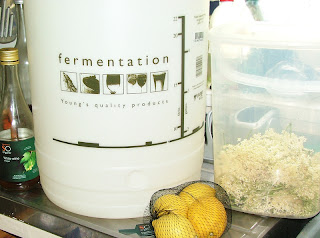Botanical image of elder and it's flowers
to help in identification
I've been asked about when we make our elderflower champagne and what we use to make it in, so I thought it might be useful to create a blog post about it in case others are interested too - I know some people were previously.
We make the elderflower champagne usually in May when they are full in flower, some areas it will be June though - often they are considered to be ready around the Summer solstice but the season is early here.
Elderflowers ready for picking
(these are from 2010)
So the recipe, which I think I promised to update last year but forgot ... sorry! There are other recipes available on the internet and in books, but this is ours after trying a couple of different balances.
Recipe for Elderflower Champagne
(makes 10 litres - adjust to what you want to make)
30-40 elderflower heads - pick the most heavily scented ones
2kg sugar
5 litres of boiling water and then cold water to make up
2 tblsp white wine vinegar (helps the brewing)
4 unwaxed lemons - Juice and zest
In a large container dissolve the sugar into the boiling water. Add cold water to increase the volume and cool the liquid (to about 9 litres-ish). Add the white wine vinegar, lemon juice and zest and the flower heads, then check the amount and add more cold water to make the level 10 litres and gently stir. Cover with a muslin cloth and leave for two days in a cool part of the house to ferment. After a couple of days fermenting usually starts - a sort of foamy scum on the surface, if it hasn't you can add a pinch of dried yeast but we've never found the need as the natural yeasts in the flowers are usually enough.
Our fermenting container
Bottled Champagne
You may need to keep an eye on screw top bottles if you choose to use them and let off a little fizz from time to time. You can also recycle plastic bottles and release some fizz when they start to bulge. But be warned that weaker bottles may explode!
We bought champagne corks and cages from a brewing shop, they weren't very expensive. We used recycled champagne bottles last year (just asked around friends who may have had some!) as other bottles aren't really strong enough - they explode spectacularly and it is very messy to clean up. We had some blow their corks last year but no bottle explosions, whereas the year before some bottles exploded ~ recycled cordial or water bottles. We store ours in the shed for safety!
Have fun and enjoy making it if you try it, but be safe!







oh thank you for that. i am so excited!!! i am definetly going to give it a go this year!!
ReplyDeletethank you.
x
Ta for that. I was just saying the other day we should make some this year.
ReplyDeletexxx